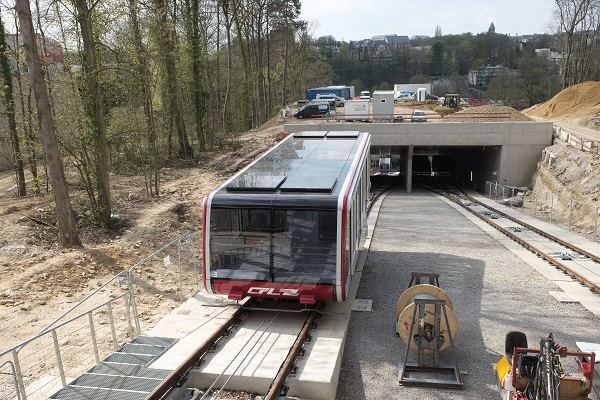
The red cabins of the new funicular railway slide effortlessly, almost gracefully, up the 200 metres that separate the Pfaffenthal and their destination. Once at the Pont Grande Duchesse Charlotte, commonly known as the "Pont Rouge" (Red Bridge), countless passengers stream out of the red cabins. At peak times, each cabin of the funicular railway, which connects the new Pfaffenthal-Kirchberg CFL train station and the Pont Rouge, can hold up to 168 people, who, once at the bridge, can continue their journeys on bike, foot, by bus or on board the new tram.
At the moment, all this lies in the future, but in a few months' time it will become reality: On 10 December 2017, the new Pfaffenthal-Kirchberg Connection Point will go into operation. The multi-level centre will not only connect Pfaffenthal and Kirchberg, it will also offer rail, bus, and tram connections as well as soft mobility and, for the first time ever in the Grand Duchy, a funicular railway connection, which every few minutes will effortlessly glide up and down the almost 40-metre-high slope between the new railway station and the Pont Rouge, taking just under one minute to complete the journey.
The Connection Point is specifically designed to allow rail passengers to access the funicular railway platform in the shortest time possible using the stairs or escalator. The ground-level cabin entrances are specially tailored to the needs of persons with reduced mobility, with five lifts also available. Pedestrians coming from Pfaffenthal can also reach the funicular railway platform via the lift, which also stops at platform level, or via the steps from Rue St. Mathieu. A footpath that winds its way up to the Pont Rouge is ideal for walking in good weather. Travellers keen to shorten their journeys with the funicular railway do not require a separate ticket. Only the stairs along the rails of the funicular railway are not intended for use by pedestrians, and instead are included for maintenance purposes and possible evacuations.
This transport innovation will allow travellers who previously had to commute through the busy city traffic towards Kirchberg from the Gare Central to save 20-25 minutes each way – a considerable time-saving. Six trains from the south and north of Luxembourg will stop at the new railway station every hour from each direction. Thus, rail travellers from the south of the country, after stopping as usual at the main railway station in Luxembourg City, will soon find themselves stopping at the new station. Passengers travelling from the north of Luxembourg to the capital, or more precisely to the Kirchberg distric, can, a few kilometres before reaching the main railway station and very close to their destination, leave the train and easily reach Kirchberg using the funicular railway.
All this is possible thanks to state-of-the-art technology from a Swiss manufacturer. The system designed for Luxembourg includes a total of four cabins, distributed across two separate tracks, which during peak times can transport up to 7,200 people per hour up- and downhill. Within ten minutes they can therefore accommodate the passengers from two crowded trains, each holding 600 people. The carriages are 11.8 metres long and 3.5 metres wide, and clad in classic "CFL Red" - a colourful eye-catcher in the cityscape. With nearly 34 square metres of standing room per cabin, they offer plenty of space for passengers who use them in the morning and evening to travel between the rail stop and the bridge. 16 folding seats are provided for those who prefer to sit down.
The two individually-constructed funicular railway systems each comprise two cabins on rails, connected to each other using a wire cable. A 680 HP electric motor and a drive pulley with a diameter of no less than 2.4 metres set the carriages in motion. On ascending and descending, they pass through a small double tunnel, where their routes cross at a passing place. With a total weight of around 17 tonnes, the funicular railway cabins each consists of two parts – a superstructure and a substructure – in order to be able to optimally adapt to the specific inclination of the track. The super- and substructures were delivered separately at the end of March 2017 and assembled on site, before being lifted onto the tracks using a crane.









